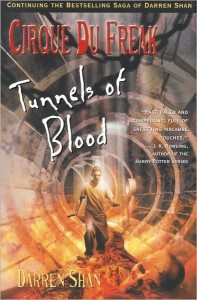 Once, Darren Shan was an ordinary teen. That is, until a fateful trip to the mysterious traveling show known as the Cirque du Freak embroiled him in a nightmare world of vampires and monsters. In Tunnels of Blood, the third book in the series, we catch up to him after he’s had some time to adjust to his new status as a half-vampire assistant to the powerful Mr. Crepsley, master of the Cirque. Frankly, once he got over the need to drink blood and slowed aging process (which for him means a long, long time as a teenager), Darren’s been enjoying himself for the most part, mastering what powers his vampiric side has granted him, and making friends with the rest of the oddities and unique people of the Cirque. His best friend is Evra, a boy with the characteristics of a great snake.
Once, Darren Shan was an ordinary teen. That is, until a fateful trip to the mysterious traveling show known as the Cirque du Freak embroiled him in a nightmare world of vampires and monsters. In Tunnels of Blood, the third book in the series, we catch up to him after he’s had some time to adjust to his new status as a half-vampire assistant to the powerful Mr. Crepsley, master of the Cirque. Frankly, once he got over the need to drink blood and slowed aging process (which for him means a long, long time as a teenager), Darren’s been enjoying himself for the most part, mastering what powers his vampiric side has granted him, and making friends with the rest of the oddities and unique people of the Cirque. His best friend is Evra, a boy with the characteristics of a great snake.
When one of Mr. Crepsley’s old friends drops by for a brief visit, Darren learns just enough of his boss’s past to tantalize and awaken his curiosity. The world of the vampires is a much bigger, complex place than he ever could have imagined, and Crepsley has many secrets. Whatever the friend wanted, he brings odd news with him, and before Darren knows it, he, Evra, and Crepsley are off to a certain city, to take care of business.
Left to their own devices, Darren and Evra soon wonder where Crepsley goes without them every night, and why he won’t explain himself. When six bodies are discovered, they begin to suspect their boss has foul play on the mind. It’s up to them to investigate, each fearing the distinct possibility that Crepsley’s gone rogue. But the truth is worse than that. Soon, Darren and Evra are caught up in a deadly cat-and-mouse game between vampire and one of the murderous vampaneze. One wrong move, and Darren could lose boss, best friend, and even his new girlfriend, who’s really just in the wrong place at the wrong time. It’ll take split-second timing if he wants to survive the climatic showdown in the sewers, and get everyone out alive.
Tunnels of Blood might be the third in the series, but to my relief, it’s accessible to the new reader, and I had no trouble at all picking up the storyline. Darren’s voice is entirely appropriate to the story, keeping us entertained without talking down to us. He’s a pleasant and sympathetic viewpoint through which we survey this dark world of vampires and things that go bump in the night. Best of all, the Cirque du Freak series approaches vampires from a new perspective, completely rewriting some of the ground rules with regards to powers, strengths, and weaknesses, giving them the fresh feel that prevents them from being overused and predictable. It’s nice to know there’s still life in the genre. If you’re looking for something different, this is a good place to start, although I might suggest reading the books in order if you get the chance, starting with Cirque Du Freak. More information may be found at www.twbookmark.com.
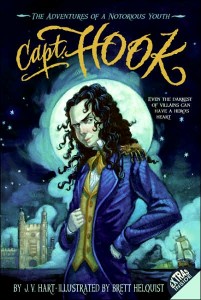 Ever wonder where the esteemed Captain James Hook came from? Well, long before the hook, the crocodile, Neverland, and a certain boy who could fly, there was just James Matthew, the bastard son of an English lord, a young man starting his scholastic career at Eton. Arrogant, overconfident, vindictive and proud, he wastes no time in making enemies of the upperclassmen, including one who’ll be his nemesis for a long time to come, a boy named Arthur Darling. James Matthew’s no ordinary boy. With his yellow blood and quick healing, keen mind and affinity for spiders, and elegant long black curls, he stands out both physically and socially. Quickly defying every tradition and custom Eton has to offer. He’ll challenge a queen, romance a Sultana, lead his compatriots to victory and glory, steal a ship, escape arrest, and leave his mark upon the buildings and inhabitants of Eton, and that’s just the start of a legendary journey. By the time it’s over, James Matthew will be dead, and Captain James Hook will be born. Along with his best friend and sidekick, Jolly Roger, he’ll become an anti-hero and a pirate, and history will never be the same.
Ever wonder where the esteemed Captain James Hook came from? Well, long before the hook, the crocodile, Neverland, and a certain boy who could fly, there was just James Matthew, the bastard son of an English lord, a young man starting his scholastic career at Eton. Arrogant, overconfident, vindictive and proud, he wastes no time in making enemies of the upperclassmen, including one who’ll be his nemesis for a long time to come, a boy named Arthur Darling. James Matthew’s no ordinary boy. With his yellow blood and quick healing, keen mind and affinity for spiders, and elegant long black curls, he stands out both physically and socially. Quickly defying every tradition and custom Eton has to offer. He’ll challenge a queen, romance a Sultana, lead his compatriots to victory and glory, steal a ship, escape arrest, and leave his mark upon the buildings and inhabitants of Eton, and that’s just the start of a legendary journey. By the time it’s over, James Matthew will be dead, and Captain James Hook will be born. Along with his best friend and sidekick, Jolly Roger, he’ll become an anti-hero and a pirate, and history will never be the same.
Acting as a prequel to Peter Pan, this is another one of those “what if?” scenarios that seeks to both humanize and explore the origins and motivations of one of literature’s most enduring and notorious villains. Where this book deviates is in its attempt to make Hook a hero in his own mind, and his own right. He’s evil, yes. He’s cunning, yes. He’s a killer and a rogue, a pirate playing his own game, yes. But he has just as many positive qualities: loyalty, honor, strength, resourcefulness, and a willingness to challenge unfair authority. It’s easy to see the young man as someone with the best of intentions, who only loses them later in life, and it would be fascinating to see how Hart takes the young Hook and fully transforms him into the one-handed hunter of Lost Boys we’re more familiar with. I do have to question the choice to give Hook his unusual healing ability, since I don’t recall Barrie’s Hook having such qualities as yellow blood or unnatural healing. But apart from that, this was a highly enjoyable read, one which almost ranks with Dave Barry and Ridley Pearson’s Peter and the Starcatchers for Peter Pan prequels. I hope we’ll see more, since it’s obvious the story isn’t finished yet.
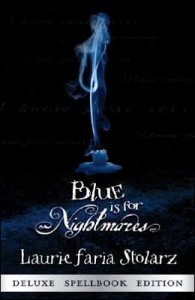 Stacey Brown’s having nightmares about her roommate again, the sort of nightmares that cause her to wake screaming and sweating. Worse still, she can’t ignore them because her dreams tend to come true, and the last time she ignored them, someone died. So now she’s juggling boarding school, an unrequited crush, and her nightmares, worried that if she can’t figure out where the danger might come from, someone else will die because of her. All she has to help her is the folk magic passed down through her family, and the support of a few friends who don’t know the full story. When another girl is horribly killed, Stacey realizes that time is growing short, and she has to act quickly.
Stacey Brown’s having nightmares about her roommate again, the sort of nightmares that cause her to wake screaming and sweating. Worse still, she can’t ignore them because her dreams tend to come true, and the last time she ignored them, someone died. So now she’s juggling boarding school, an unrequited crush, and her nightmares, worried that if she can’t figure out where the danger might come from, someone else will die because of her. All she has to help her is the folk magic passed down through her family, and the support of a few friends who don’t know the full story. When another girl is horribly killed, Stacey realizes that time is growing short, and she has to act quickly.
Blue is for Nightmares is an interesting book. Part teen thriller a la Christopher Pike and part dark fantasy, it mixes in a generous supply of folk magic and superstition, unsurprising since Llewellyn is best known for its line of occult and New Age publications. The plot suffers a little from familiarity, and a lot from the frequent digressions into descriptions of New Age or Wiccan practices. I enjoyed Blue is for Nightmares, but found some of its aspects distracting. It’ll likely appeal to the same audience that buys other Llewellyn books, but it lacks a wider appeal.
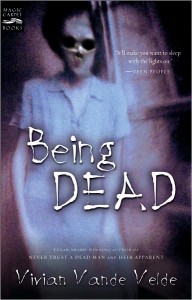 This creepy little collection of short stories all focuses on one thing: that eerie dichotomy between the living and the dead. Seven tales of ghosts and spirits, and things that definitely go bump in the night because they’re not ready to move on quite yet. Dark and atmospheric, each selection is uniquely suited for keeping the reader up late at night with all the lights on.
This creepy little collection of short stories all focuses on one thing: that eerie dichotomy between the living and the dead. Seven tales of ghosts and spirits, and things that definitely go bump in the night because they’re not ready to move on quite yet. Dark and atmospheric, each selection is uniquely suited for keeping the reader up late at night with all the lights on.
The title story, “Being Dead,” starts off in an unusual way: a paperboy in 1930’s New York is killed when a suicidal man leaps from a window. Understandably irked by the whole thing, Johnny chooses to remain on Earth as a spirit, and sulk for a while. Will he let anger and a thirst for revenge get in the way of the afterlife?
In “October Chill,” a young woman has to come to terms with her inevitable death. When a ghost from the past enters her life, she’s forced to reconsider whether she really wants to fight to live. “The Ghost,” on the other hand, is a succinctly short story of a ghost who just can’t resist scaring away those who enter its home. “Dancing with Marjorie’s Ghost” is a story with a moral, as an abusive husband gets exactly what he deserves after his wife passes on. “Shadow Brother” deals with the return of a ghost with some unfinished business and the family secrets that affect such an event. “For Love of Him” is an especially strange tale, about a young man who inadvertently gets caught up in a love story that played out decades ago yet whose power still lingers to this day. Finally, :Drop by Drop,” the longest story in the book, is also the most skin-crawling, in my opinion. A teenage girl who’s just moved to the country suffers repeated visits from an angry ghost, and the secret that links them is more horrifying than expected.
All in all, this is a great collection if you like ghost stories, and don’t mind the stories lingering in your mind long after you’ve closed the book and turned off the lights.
 For Princess Tatiana Anatolia, better known as Ana, nothing matters more to her than gaining the approval and love of her mother, a woman whose dominant characteristic is her overwhelming vanity. When Ana realizes that she might very well surpass her mother in beauty, and as a result, lose her mother’s love, she engages upon a self-destructive path of overeating, physical neglect, and self-abuse, ruining her own looks. Thus, she reasons, she’s safe, and perhaps she can win her mother’s favor once more, no matter what the toll is on her body. However, Ana’s not safe from the whispered advice of her mother’s favorite advisor, a strange little man known as the Beauty Consultant, and soon Ana, along with fifty of the kingdom’s most attractive girls, are sent away to the Academy for Girls. But at the Academy, a secret is brewing, and being beautiful is a curse. Only Ana has the mental strength to realize what’s going on and stop it before it’s too late, but she too is being seduced, by the freedom to be herself and be pretty once again. But to save her friends, she may have to sacrifice it all once more.
For Princess Tatiana Anatolia, better known as Ana, nothing matters more to her than gaining the approval and love of her mother, a woman whose dominant characteristic is her overwhelming vanity. When Ana realizes that she might very well surpass her mother in beauty, and as a result, lose her mother’s love, she engages upon a self-destructive path of overeating, physical neglect, and self-abuse, ruining her own looks. Thus, she reasons, she’s safe, and perhaps she can win her mother’s favor once more, no matter what the toll is on her body. However, Ana’s not safe from the whispered advice of her mother’s favorite advisor, a strange little man known as the Beauty Consultant, and soon Ana, along with fifty of the kingdom’s most attractive girls, are sent away to the Academy for Girls. But at the Academy, a secret is brewing, and being beautiful is a curse. Only Ana has the mental strength to realize what’s going on and stop it before it’s too late, but she too is being seduced, by the freedom to be herself and be pretty once again. But to save her friends, she may have to sacrifice it all once more.
A none-too-subtle allegory about the price of beauty in today’s society, the drive for acceptance from family and peers, and the lengths some people will go to in order to maintain their youthful looks, Beauty is a fairly quick-paced story with a likeable, intelligent, resourceful protagonist. Unfortunately, it does feel rushed near the end, the climax arriving and concluding with some haste. Furthermore, the thread involving the Beauty Consultant character is never really fleshed out, leaving him as something of an enigma that bears explaining. Beauty is a good book, well-told and enjoyable, but over far too quickly and with a few minor flaws. I hope we’ll see more YA books from this author, though, as she shows a great deal of promise.
This is the inaugural volume of a new series of picture books starring Babu the Water Buffalo, a young hero who gets involved in all sorts of adventures while learning about life and growing up in India. Meet Malla the Kawwa bird, Babu’s parents Mataji and Pitahji, Singh the King Cobra, and Mohan the Mongoose, and learn all about the perils that await a young water buffalo who wanders off on his own.
The first release from Babu Books, a new publisher of children’s books, Babu the Buffalo is an extremely strong example of what’s to come. The story, while short (less than 20 pages), manages to pack a remarkable amount of information and characterization and deliver a complete adventure. The art is absolutely gorgeous, the characters expressive and filled with a childlike whimsy, the colors rich and glowing and all but jumping off the page. As an added, and most welcome, bonus, there’s a four page vocabulary list in the back of the book, covering a wide variety of the words found in the actual story. Educational as well as lovely, Babu is clearly the start of something good. This is one book I’ll definitely be keeping until I have children to share it with. You can learn more at www.babubooks.com.
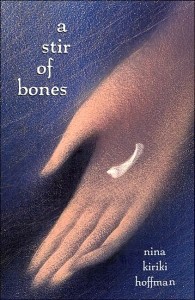
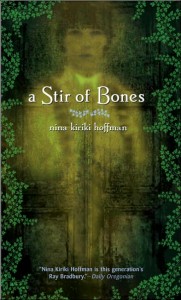 Prequel to Nina Kiriki Hoffman’s previous books, Red Heart of Memories and Past the Size of Dreaming, A Stir of Bones can be read as a stand-alone with no problems at all.
Prequel to Nina Kiriki Hoffman’s previous books, Red Heart of Memories and Past the Size of Dreaming, A Stir of Bones can be read as a stand-alone with no problems at all.
The year is 1981, and 14 year old Susan Backstrom’s life is seemingly perfect on the outside. She’s beautiful, well-mannered, well-educated and intelligent, and her family is well-to-do and attentive. But all of that masks her father’s dark intensity bordering on obsession. Susan’s life is not her own, and any free time she has is hard won and jealously guarded. When she overhears a friend of hers, Julio, talking with several other kids about a secret place they can go and be alone, Susan convinces them to let her join in. That’s how they they meet House, an abandoned building that thrives with a life all its own, and Nathan, a ghost who’s been dead for decades. That’s how Susan makes the friends that could live a lifetime. And with a safe place and people she trusts, she can finally explore the mysterious abilities that have always been hers to command: to sense the life around her, to communicate with the inanimate, and, it seems, to touch the dead. As Susan’s confidence and power grows, her inner shell begins to crack, threatening to release things she’s kept inside all her life. But does she have what it takes to change her life for the better, or will she take the easy route out and end up like Nathan, dead but still among the living?
A Stir of Bones mixes the darkness of personal secrets with the light of hope and friendship, offering up a thoughtful look at all too common problems. The topics tackled may be a bit on the mature side, but they need to be addressed. Hoffman, with her ability to pointedly mix magic and reality seamlessly, is able to take an ordinary story and infuse it with a unique sort of beauty and wonder that few authors can match. Susan’s struggle and personal growth, and the aid of her friends, provide a fascinating, provocative look into the dark corners that exist in even the brightest homes. Hoffman never disappoints, but this is better than usual even for her.
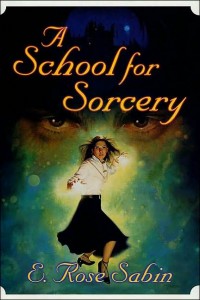
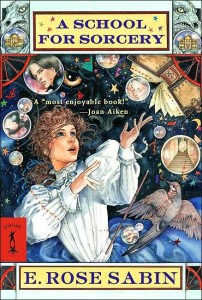 When Tria is invited to attend the prestigious Lesley Simonton School for the Magically Gifted in the land of Arucadi, she has no way of knowing what to expect. It’s supposed to be the best place in the land for developing the increasingly rare magical gifts in a world inexorably moving towards science and machinery. What Tria finds, though, fails to live up to her expectations. The staff is almost nil, the Headmistress abrupt and strict, the buildings small and miserably shabby, and her new roommate is a self-centered, rude, manipulative girl who turns into a panther when angry. Somehow, Tria manages to get into trouble within hours of arrival. It’s not a good start.
When Tria is invited to attend the prestigious Lesley Simonton School for the Magically Gifted in the land of Arucadi, she has no way of knowing what to expect. It’s supposed to be the best place in the land for developing the increasingly rare magical gifts in a world inexorably moving towards science and machinery. What Tria finds, though, fails to live up to her expectations. The staff is almost nil, the Headmistress abrupt and strict, the buildings small and miserably shabby, and her new roommate is a self-centered, rude, manipulative girl who turns into a panther when angry. Somehow, Tria manages to get into trouble within hours of arrival. It’s not a good start.
Even after making friends, Tria is still caught up in scholastic intrigues, as her roommate, Lina, begins to jockey for power among the other students. The inevitable clash of power is enough to make even Tria reevaluate her place at school, and their bizarre plans for her. It all comes to a head when another student’s prank goes horribly wrong, causing several people to be trapped in another dimension, the realm of the much-feared Dire Ladies. Tria, charged with bringing them back, has to draw deep upon her untapped potential, and gather her friends together for a showdown that could ultimately destroy her.
Harry Potter, this most certainly is not. If anything, it bears a stronger resemblance to Caroline Stevermer’s A College of Magics, featuring a strong female protagonist in a scholastic setting. Things are never what they appear to be in this book, with illusion and misdirection abounding, both in the setting and in the actual plot. It’s a good, fun read, if a little confusing in the last quarter or so, when things really get hairy. I’m also a little disappointed that Sabin chooses to jump forward in time for the last chapter; I wouldn’t have minded to see more of Tria’s time at the school. This is a setting that deserves further exploration, and I hope we’ll see more from the author.
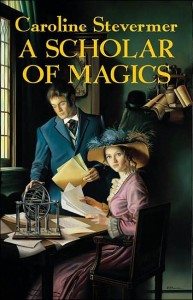
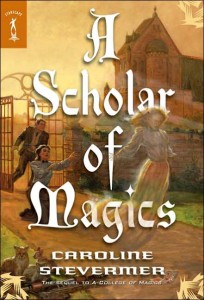 Samuel Lambert is an American sharpshooter and adventurer. Jane Brailsford is an English lady with a talent for defying propriety while maintaining her dignity. An unlikely pair, they’re thrown together by unusual circumstances when a secret military project being conducted on the premises of Glasscastle University, England’s preeminent place of magical learning, goes slightly awry. Together and separately, Jane and Samuel must get to the bottom of a bizarre plan before it’s too late. Kidnapings, assassination attempts, hidden identities, secret weapons, magical bowler hats, killer grass, disgruntled students, and improperly served tea are all among the hazards they’ll face over the course of their time together. And then there’s the mild-mannered Glasscastle don with unimaginable power and no desire to use it, some fast motorcars, and all sorts of other fun, to boot. Set in the early years of the 20th Century of an alternate world where magic is real and Europe is just a bit stranger than we’d expect, A Scholar of Magics is a kind-of-sequel to Stevermer’s previous book, A College of Magics.
Samuel Lambert is an American sharpshooter and adventurer. Jane Brailsford is an English lady with a talent for defying propriety while maintaining her dignity. An unlikely pair, they’re thrown together by unusual circumstances when a secret military project being conducted on the premises of Glasscastle University, England’s preeminent place of magical learning, goes slightly awry. Together and separately, Jane and Samuel must get to the bottom of a bizarre plan before it’s too late. Kidnapings, assassination attempts, hidden identities, secret weapons, magical bowler hats, killer grass, disgruntled students, and improperly served tea are all among the hazards they’ll face over the course of their time together. And then there’s the mild-mannered Glasscastle don with unimaginable power and no desire to use it, some fast motorcars, and all sorts of other fun, to boot. Set in the early years of the 20th Century of an alternate world where magic is real and Europe is just a bit stranger than we’d expect, A Scholar of Magics is a kind-of-sequel to Stevermer’s previous book, A College of Magics.
The end result is a cross between Gilbert and Sullivan, and Steed and Peel (aka the Avengers), and strangely enough, it works. Jane and Samuel are a perfectly mismatched pair, and as a result, they carry the story beautifully, their contrasting personalities at odds with one another and with the well-behaved background characters of Glasscastle and England-at-large. There’s enough twists and turns and surprises to keep everyone on their toes, and very little is predictable. Part mystery, part fantasy, part adventure, part romance, A Scholar of Magics is pure fun. It’s also blessed with one of the best covers I’ve seen in ages, courtesy of David Bowers. Pure and simple, I loved this book, and I hope we’ll get to see more of Jane and Samuel in the future.
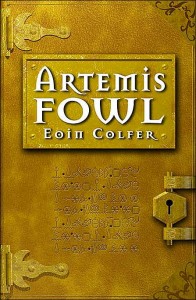 Artemis Fowl is a millionaire and criminal genius, at the tender age of twelve. With his father missing and his mother ill, it’s up to him to keep the family going, and he has some distinctly unusual views on how to restore their much-dwindled fortunes. Holly Short is an elf, part of the crack LEPrecon Unit, responsible for tracking down wayward members of the fairy race and cleaning up problems. Above all, she has to keep the human race unaware of the magical beings that dwell in secret deep underground. When Holly and Artemis cross paths, things are bound to get messy. Holly’s running short on magic, and only a ritual conducted out in the open will give her the juice she needs. Artemis has a copy of the Book, the collective wisdom and rules of fairy society. All he needs is an opportunity. And he gets it.
Artemis Fowl is a millionaire and criminal genius, at the tender age of twelve. With his father missing and his mother ill, it’s up to him to keep the family going, and he has some distinctly unusual views on how to restore their much-dwindled fortunes. Holly Short is an elf, part of the crack LEPrecon Unit, responsible for tracking down wayward members of the fairy race and cleaning up problems. Above all, she has to keep the human race unaware of the magical beings that dwell in secret deep underground. When Holly and Artemis cross paths, things are bound to get messy. Holly’s running short on magic, and only a ritual conducted out in the open will give her the juice she needs. Artemis has a copy of the Book, the collective wisdom and rules of fairy society. All he needs is an opportunity. And he gets it.
What starts as a simple kidnapping soon turns into all-out war between fairy and human, as Holly’s colleagues come to free her from Artemis’ diabolical clutches, by any means necessary. Armed with magic and technology, facing off against a foe twice as cunning and just as ruthless, they’ll be hard-pressed to find a positive spin on the situation. Artemis knows too much about them, and his associates are rather well trained in dealing with opponents. The best anyone may hope for in the end is to survive…
Part Men in Black, part James Bond, with a healthy dose of something unquantifiable thrown in for good measure, the Artemis Fowl books are technothrillerfairy adventures for the young adult, and something refreshingly different for a field that really has seen it all.
